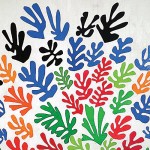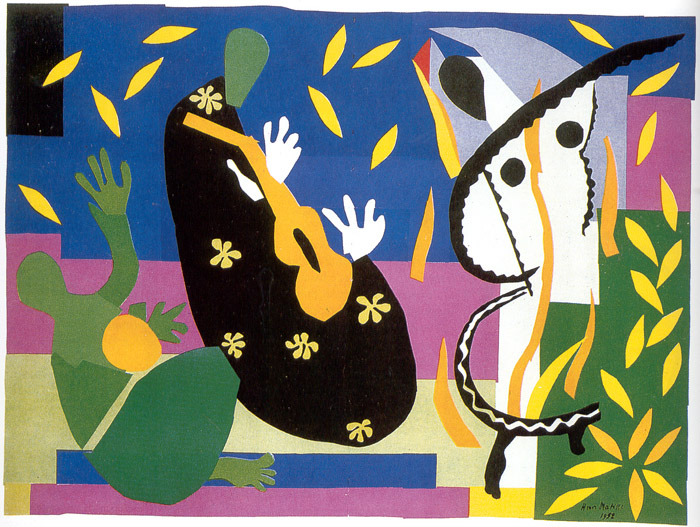
Art therapy is a scarce resource in mental health. In my time in mental health I have come across two art therapists. Both were part-time.
This is particularly striking when it is considered that NICE recommends that referral to arts therapies should be considered for all people diagnosed with schizophrenia. The rationale being that conventional medication-based and psychological therapies have only limited effects on the so called negative symptoms of psychosis.
In addition, arts therapies may help people to understand themselves while containing powerful emotions that might otherwise overwhelm them. This fits with my own clinical experience. I can recall people who found conventional psychological therapy very difficult but seemed to find art therapy more helpful.
The MATISSE trial
The MATISSE (Multicenter Study of Art Therapy in Schizophrenia: Systematic Evaluation) study (Crawford et al, 2012) aimed to examine the impact of adding art group therapy to the treatment of people diagnosed with schizophrenia compared to an active control treatment and standard care alone. It was published in the BMJ and we blogged about it on the Mental Elf in March 2012.
It was a “pragmatic” trial with 417 participants from across the UK, all diagnosed with schizophrenia. Treatment lasted 12 months and the primary outcomes measures were the Global Assessment of Functioning scale and the Positive and Negative Symptoms Scale (PANSS) measured at 24 months after randomisation. Primary and secondary outcomes between the three study arms did not differ.
The authors suggested that referral to art therapy does not lead to improved outcomes for most people diagnosed with schizophrenia although they noted that:
We cannot rule out the possibility that group art therapy benefits people with schizophrenia who are motivated to use this treatment.

The MATISSE trial challenged existing NICE guidance which recommends that clinicians should consider referring all people with schizophrenia for arts therapies
The Critique
The MATISSE study could have fairly serious implications for people diagnosed with schizophrenia as well as for services and art therapists. Holttum and Huet (2014) have recently published a paper with the stated aim of “determin[ing] whether radical changes were needed in art therapy or whether the trial’s conclusion should be challenged”.
Sue Holttum is employed as a research officer for the British Association of Art Therapists while Val Huet is the Chief Executive Officer of the same organisation. Their critique examined six papers reporting on various aspects of the MATISSE trial. They compared the trial against criteria derived from the MRC guidelines for trials of complex interventions.
Main criticisms of the MATISSE trial
Holttum and Huet criticised the MATISSE trial on the following grounds:
- There was no mention of the use of a recognised framework for testing complex interventions.
- The MATISSE authors had not clearly established the relevant mechanisms of art therapy for the client group.
- Only Randomised Controlled Trials (RCTs) were considered by the MATISSE authors in their review of the literature.
- The MATISSE authors did not mention piloting in their reporting of the study.
- There was insufficient service user involvement in the study.
- Adaptation to the various different settings was not adequately considered by the MATISSE authors.
- The outcome measures were considered by Holttum and Huet to be inappropriate.
- There was no plan for subgroup analyses.
- Process analysis was not adequately addressed to explain discrepancies between expected and observed outcomes.
- The reporting framework did not take into account the problem of staff preselecting clients to refer to trials in a way which was not documented.
- Variations in practice were not considered other than to ensure treatment fidelity.
- Contexts and changes were not considered by the MATISSE authors.
- The use of Intention to Treat (ITT) statistical analyses was considered by Holttum and Huet to be inappropriate since there was a very high drop-out rate for all arms of the study.

Perhaps unsurprisingly, the British Association of Art Therapists were highly critical of the MATISSE trial and it’s findings
Holttum and Huet conceded that they had incomplete access to the details of what happened during MATISSE but they opined that the MATISSE conclusions were “unwarranted” and that “rather than needing to disseminate lessons for art therapy practice, it appears that we are no further forward as a result of MATISSE”.
They noted that the mechanisms for art therapy should be elucidated and that future research should seek to elucidate the “mechanisms occurring for people given a diagnosis of schizophrenia”.
In a strident conclusion, Holttum and Huet note that:
The trial conclusions, published in a relatively prestigious journal, may have a damaging influence, such that vulnerable people who rarely receive much more than maintenance on medication will be deprived of a therapy that could change the lives of at least some, if not many.
Discussion
It is not clear from the Holttum and Huet paper whether the MATISSE authors were alerted to the critique of their paper and given right of reply as I would be interested to hear their defence. Interestingly, despite the stated aim of Holttum and Huet being to determine whether radical changes are needed to art therapy this does not appear to have been considered anywhere in their critique. Indeed, I struggled to find anything positive they had to say about the MATISSE trial.
Although Holttum and Huet make some fair comments about the limitations of the MATISSE trial (for example, their observation that the very high drop-out rates could have skewed the results) I think that many of their criticisms would not have had a substantive impact on the results of the trial. In my view, the fact that piloting was not mentioned in the reporting of the study, or that only RCTs were considered in the MATISSE literature review would have only minor (if any) effects on the reported results.
I also wonder about the notion that “the relevant mechanisms of art therapy” should have been understood by the MATISSE authors, largely non-art-therapists. I would have thought that it would be important to test out IF an intervention works before there is then an investigation of HOW it works.
On balance, I do not consider the Hulttum and Huet critique to be particularly convincing. The MATISSE trial was by no means perfect but the authors noted from the outset that it was pragmatic.
If Holttum and Huet wish to defend the use of art therapy in psychiatric settings then a next step may be to encourage art therapists to conduct their own high quality research in this area.

Art therapy might intuitively feel like a good thing to do, but without high quality evidence to support it, should guidelines be recommending its use?
Links
Holttum S and Huet V. The MATISSE Trial−A Critique: Does Art Therapy Really Have Nothing to Offer People With a Diagnosis of Schizophrenia? SAGE Open 2014 4: DOI: 10.1177/2158244014532930
Crawford, MJ et al. Group art therapy as an adjunctive treatment for people with schizophrenia: multicentre pragmatic randomised trial. BMJ 2012;344:e846.


RT @Mental_Elf: Art therapy for schizophrenia: an effective add-on treatment? http://t.co/NjRw1hiW9L
Here we go again: “@Mental_Elf: Art therapy for schizophrenia: an effective add-on treatment? http://t.co/gQeFf8Bc76”
@Mental_Elf Horses for courses – some people gain from Art Therapy IME. Others don’t – in which case try something else.
#Art therapy for #schizophrenia: an effective add-on treatment?
http://t.co/CE38MLRB74 via @ShareThis @Mental_Elf
#mentalhealth #psychiatry
Art therapy for schizophrenia: an effective add-on treatment?: The MATISSE trial in 2012 concluded that group … http://t.co/AoSZ0Yq45s
Art therapy for schizophrenia: an effective add-on treatment? @Mental_Elf covers recent @UCLPsychiatry paper. http://t.co/1msADUurTF
Today @JoeJudgePsy looks at a recent critique of the MATISSE RCT, written by @baat_org http://t.co/08Ij6WQo0D #ArtTherapy #Schizophrenia
Art therapy for schizophrenia: an effective add-on treatment? http://t.co/Tmi8BCeHxn via @sharethis
Do you have personal experience of #ArtTherapy helping you recover from #Schizophrenia? Pls share on our blog today: http://t.co/08Ij6WQo0D
@Mental_Elf @BPSOfficial Copying in the FAB @PortugalPrints Art Therapy practice of @Westminstermind (contribution from Services Users?)
Hampshire Healthcare Library Service liked this on Facebook.
Mental Elf: Art therapy for schizophrenia: an effective add-on treatment? http://t.co/gCFl4ngl5C
Where’s the research evidence for #ArtTherapy helping people with #Schizophrenia? http://t.co/08Ij6WQo0D
Good question!!! RT @Mental_Elf Where’s the research evidence for #ArtTherapy helping people with #Schizophrenia? http://t.co/kL0BblbZfu
@Mental_Elf Responses to the Matisse trial make a mockery of evidence-based practice and NICE guidelines on psychosis
Even the Matisse authors’ own conclusions are so conditionally tempered as to be meaningless @Mental_Elf
I have found painting has helped me express feelings and thoughts that I couldn’t explain with words. My counsellor used art therapies with me and I opened up a new deeper level of understanding
Jason Desoisa liked this on Facebook.
¿Aporta algo el arteterapia al tratamiento de la esquizofrenia? http://t.co/qaHEpBvm0C Por lo general, no. Quizá algo, a algunos…
Nicola Davies liked this on Facebook.
“Art Therapy for schizophrenia” from @JoeJudgePsy @Mental_Elf http://t.co/PEqOSnJ67Z Even less “evidenced-based” than CBT…
My latest blog for @Mental_Elf looking at art therapy in mental health – http://t.co/ElaAogkC0A
@JoeJudgePsy @Mental_Elf I read the holttum paper a few weeks ago – struck me as a vitriolic scatter-gun critique of MATISSE/
@JoeJudgePsy @Mental_Elf I thought Matisse conclusions were measured given it’s pragmatism. Critics must be producing pristine research.
“@JoeJudgePsy: My latest blog for @Mental_Elf looking at art therapy in mental health – http://t.co/7CtvSJ7aiU”acceptd by patients,underused
Don’t miss – Art therapy for schizophrenia: an effective add-on treatment? http://t.co/08Ij6WQo0D
Art therapy for schizophrenia: an effective add-on treatment? http://t.co/Y2fLIxu3ah vía @sharethis
http://t.co/64Ev9Ql1XI
Mental Elf finds Matisse trial is good evidence art therapy is sadly not helpful for schizophrenia http://t.co/s4kEfd0ipO via @sharethis
Art therapy for #schizophrenia: an effective add-on treatment? – The Mental Elf http://t.co/kLpqx1n0Xn
Art therapy for schizophrenia: an effective add-on treatment? – The Mental Elf http://t.co/kHFcU6WRcC
Joe Judge is right to suggest that art therapists conduct their own high quality research into art therapy. As yet there is relatively little such research published by art therapists. However, one promising trial was carried out in the UK, by Richardson, Jones, Evans, Stevens and Rowe (2007). That trial suggested that art therapy was helpful for ‘negative symptoms’ such as social withdrawal and loss of motivation in people with a diagnosis of schizophrenia.
In my view, one of the most problematic aspects of the MATISSE trial was low attendance of art therapy and activity groups in the two active arms of the trial. Participants were randomly assigned to attend art therapy or activity groups once a week for a year, so they could have attended over 40 sessions. However, what actually happened was that less than one third of participants attended more than nine sessions in total. Thus, the majority of participants attended no or only a few sessions.
Even so, as is standard in these trials and considered good practice, most were followed up and paid to have an assessment two years later, even though they had not gone to any sessions for over a year, and in most cases the sessions they did attend would have been nearly two years earlier because they stopped going so early. As I say, this is all standard procedure in these kinds of trials. If you don’t follow people up, you are left with only people who stayed in so they must have been those who were more motivated to attend the therapy – so that could bias the results in favour of the therapy under investigation. The assumption is that the therapy must have been poor for people not to continue attending.
However, there is evidence that there may have been considerable obstacles for at least some people to attend, such as long journeys on poor public transport (Patterson, Borschmann & Waller, 2013). For people struggling with low motivation, it can be an effort to attend something new, without it being difficult to get to. In addition it is unclear how fully the local mental health services understood art therapy or encouraged people to attend. Patterson, Debate, Anju, Waller and Crawford (2011) reported evidence that art therapy is not always well integrated into mental health services, but NICE (2009) suggested services need to work together to best help people with the diagnosis of schizophrenia. Patterson, Kramo, Soteriou and Crawford (2010) reported that some staff were reluctant to refer people to the MATISSE trial, and in one place, referred them to an alternative art therapy service outside the trial. It does not sound like participants were universally encouraged to attend the trial sessions.
On the one hand it could be argued that this was art therapy as usually practiced, and it was shown to be ineffective. But the counter-argument is that we know already that poorly integrated services will struggle and that people who struggle with motivation and energy might be more likely to attend a therapy with encouragement from others in their mental health team who understand its value. It seems to me that if many of the problems encountered in the MATISSE trial were external to art therapy itself, then it may be premature to challenge the NICE guideline of considering it for people. Surely the real issue is services working more closely together?
There is also the question of being randomly assigned to art therapy, activity groups, or usual care. This is the ‘gold standard’ of randomised trials, but it is not the way people normally enter therapy. No matter how ‘pragmatic’ such a trial attempts to be, randomisation is not reflective of usual practice for any therapy. People who really want art therapy might avoid such a scenario, especially when they would be obliged not to do any art therapy for another whole year after the intervention period. Those who don’t want it would end up in a therapy they did not want, making the therapist’s job more difficult from the outset.
I do concede that these kinds of trials are difficult to conduct. I can also point out that a lot of the additional evidence cited here was from the process studies conducted by authors of the MATISSE trial, since they recognized these are helpful in understanding the findings. However, I do not think the authors have a case for challenging the NICE (2009) guidelines. These guidelines do not say people should be given art therapy. They only say that arts therapies (including drama and music) should be considered for all people with a diagnosis of schizophrenia. I do not think the MATISSE trial findings are grounds for challenging these very reasonable guidelines.
The NICE (2009) guidelines also reported that service users themselves who had had the opportunity to attend arts therapies, which was not very many, had positive things to say about them.
The art therapy for schizophrenia discussion is getting interesting @JoeJudgePsy http://t.co/08Ij6WQo0D
Great blog-post on @Mental_Elf: ‘Art therapy for schizophrenia: an effective add-on treatment?’ by @JoeJudgePsy http://t.co/vvmn5VzTzQ
Just to add to my co-author’s points and some other comments: another important learning point was that the lack of clear practice descriptions needed addressing. This lack is entirely our profession’s responsibility and we are in the process of developing practice guidelines with involvement not only of art therapists but of carers and service users. The MATISSE trial was a painful but ultimately very helpful experience that has highlighted the need to articulate what we do and identify through research active factors for specific client groups. The MATISSE critique is therefore in no way an excuse for not getting on with research – in fact, it has really highlighted what needs to be done and is now at the forefront of our research strategy. However our view still stands that as an RCT with amongst other issues, no agreed practice descriptions and poor recruitment (one of its arms was run in a place where there was no established mental health service, hence poor recruitment), MATISSE’s results are challengeable. Val Huet, CEO, BAAT
The Mental Elf liked this on Facebook.
The Mental Elf liked this on Facebook.
Nicola Davies liked this on Facebook.
Jason Desoisa liked this on Facebook.
Hampshire Healthcare Library Service liked this on Facebook.
I would like to make it clear that (1) Art therapists were closely involved in every stage of the study (2) We were not offered any ‘right to reply’ to the Hollttum & Huet article.
In the trial we tested the hypothesis that offering group art therapy to most people with psychosis could improve their mental health and global functioning. We found no evidence to support this hypothesis. In a secondary analysis we found no evidence that people who attend more groups had better outcomes.
[…] J. Art therapy for schizophrenia: an effective add-on treatment? The Mental Elf. 27 Jun […]
[…] Art therapy for schizophrenia: an effective add-on treatment? […]